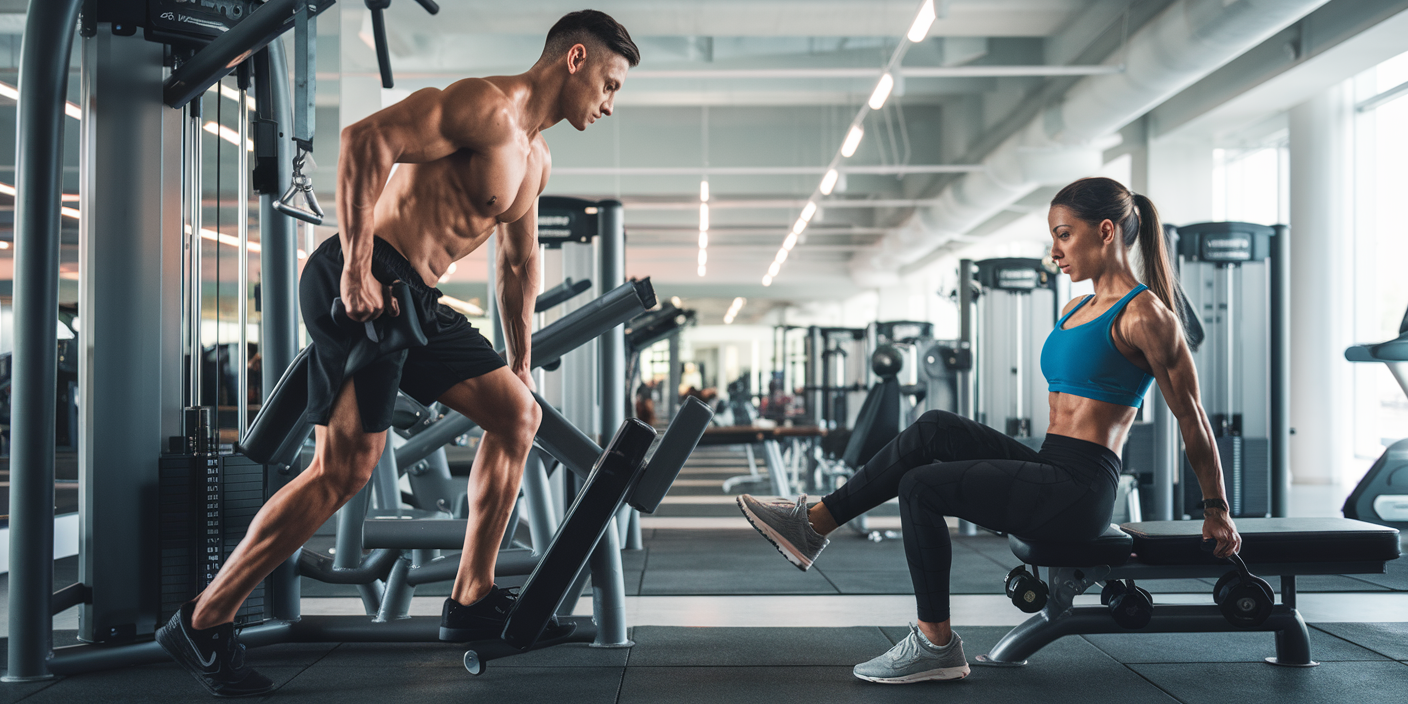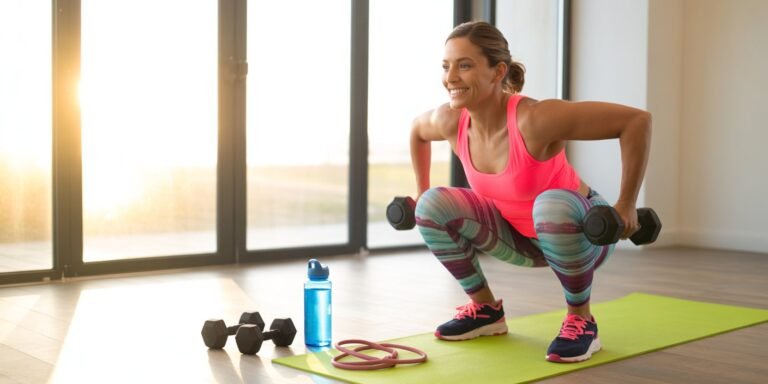Why Calf Training is Important
When most people think about leg workouts, they often focus on quads, hamstrings, and glutes—but the calves are frequently overlooked.
This small yet powerful muscle group plays a critical role in overall leg strength, athletic performance, and aesthetic balance.
Here’s why training your calves should be a non-negotiable part of your fitness routine.
1. Improves Lower Body Strength and Stability
The calves, composed primarily of the gastrocnemius and soleus muscles, are essential for stabilizing your ankles and knees during movements like running, jumping, and squatting. Strong calves:
- Enhance your ability to perform lower body exercises more efficiently.
- Reduce the risk of injuries by stabilizing joints.
- Improve balance during functional movements like walking, hiking, or climbing stairs.

2. Boosts Athletic Performance
Calf strength is key for explosive movements in sports and fitness:
- Running & sprinting: Strong calves generate more power in each step, improving speed and endurance.
- Jumping: Calves contribute to vertical leap and explosive power.
- Cycling & rowing: Calf muscles assist in pedal and push motions, enhancing performance.
Athletes often neglect calves, but well-trained calves can make a significant difference in overall performance.
3. Enhances Aesthetic Proportion
Calves are the foundation of lower leg aesthetics. Even with well-developed thighs and glutes, underdeveloped calves can make your legs look out of proportion.
Regular calf training:
- Creates balanced and sculpted lower legs.
- Adds definition and a strong, athletic look.
- Improves overall leg symmetry, which is important for physique competitions or simply for a toned appearance.
4. Supports Daily Activities
Strong calves aren’t just for looks or sports—they play a role in everyday life:
- Walking, running errands, climbing stairs, and standing for long periods become easier.
- Calves help absorb shock and reduce strain on knees and ankles.
- Reduces fatigue in the lower legs during prolonged activity.
5. Boosts Calorie Burn
Though relatively small, calves are muscle-dense, which means training them can:
- Increase metabolic rate slightly during and after workouts.
- Improve circulation in the lower legs.
- Support overall fat-burning goals as part of a well-rounded leg routine.
6. Tips for Effective Calf Training
- Include both standing and seated exercises: Standing calf raises target the gastrocnemius, while seated calf raises emphasize the soleus.
- Use progressive overload: Gradually increase weight or resistance to stimulate growth.
- Perform higher reps for endurance and definition: Calves respond well to 12–25 reps per set.
- Stretch and mobilize: Proper flexibility reduces injury risk and improves range of motion.
Bottom line: Calf training is essential for strength, performance, aesthetics, and injury prevention.
Ignoring calves can limit your lower body potential, while consistent calf workouts contribute to balanced, functional, and strong legs.
Incorporate a mix of standing and seated calf exercises into your routine to maximize results.
Anatomy of the Calf Muscles
Understanding the anatomy of the calf muscles is key to training them effectively. The calves may look small compared to other leg muscles, but they are complex, powerful, and essential for movement, balance, and aesthetics.
The calf region primarily consists of two major muscles: the gastrocnemius and the soleus, along with several smaller supporting muscles.
1. Gastrocnemius
- Location: The gastrocnemius is the larger, more prominent muscle that forms the visible “bulge” of the calf. It runs from the back of the femur (thigh bone) down to the Achilles tendon at the heel.
- Function:
- Responsible for plantar flexion (pointing the toes downward).
- Assists with knee flexion.
- Provides explosive power for jumping, sprinting, and running.
- Training Tip: Standing calf raises are particularly effective for targeting the gastrocnemius because the knee is straight, putting this muscle under maximum stretch and contraction.
2. Soleus
- Location: The soleus lies underneath the gastrocnemius and is flatter and wider. It originates from the tibia and fibula (bones of the lower leg) and also attaches to the Achilles tendon.
- Function:
- Primarily responsible for plantar flexion.
- Plays a major role in endurance activities like walking and running.
- Supports posture by stabilizing the ankle and lower leg.
- Training Tip: Seated calf raises target the soleus because the knee is bent, which shifts the emphasis from the gastrocnemius to the soleus.
3. Other Supporting Muscles
While the gastrocnemius and soleus are the main calf muscles, a few smaller muscles also contribute to lower leg movement:
- Plantaris: A small, thin muscle that assists the gastrocnemius with plantar flexion.
- Tibialis posterior: Located deeper in the lower leg, it stabilizes the ankle and supports the arch of the foot.
- Peroneal muscles: Run along the outer part of the lower leg and help with foot eversion and stability.
4. Achilles Tendon
- The Achilles tendon connects the gastrocnemius and soleus to the heel bone.
- It is critical for transmitting the force generated by the calves to allow walking, running, jumping, and pushing off the ground.
- Keeping this tendon flexible and strong is important to prevent injuries like tendonitis or tears.
5. Key Takeaways for Training
- To fully develop the calves, it’s important to target both the gastrocnemius and soleus using a variety of exercises and angles.
- Standing exercises emphasize the gastrocnemius, while seated exercises target the soleus.
- High repetitions, progressive overload, and proper stretching are essential because calves are endurance muscles that require both strength and volume to grow.
Bottom line: The calf muscles are more than just a small part of the leg—they are a critical combination of strength, endurance, and stability muscles.
Understanding the anatomy helps you design effective training routines that target both the gastrocnemius and soleus for balanced, strong, and aesthetic lower legs.
Best Calf Exercises for Strength & Growth
Standing calf raises are one of the most effective exercises for building size, strength, and definition in the gastrocnemius, the prominent upper portion of the calf.
This exercise is simple to perform but can deliver significant results when done consistently with proper form and progressive overload.
1. Standing Calf Raises
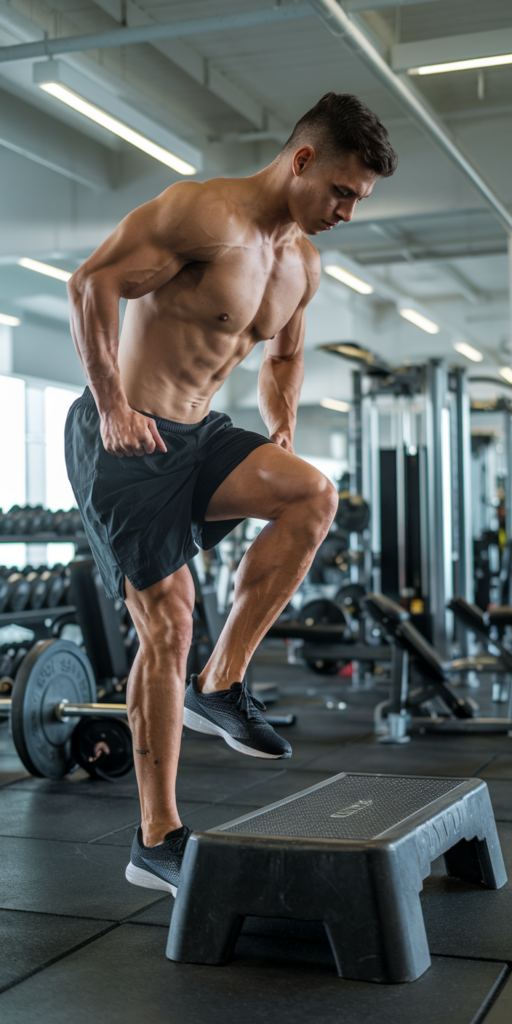
How to Perform Standing Calf Raises
- Starting Position: Stand upright with your feet shoulder-width apart. You can hold onto a wall, railing, or dumbbells for balance.
- Movement:
- Slowly rise onto the balls of your feet, lifting your heels as high as possible.
- Pause for 1–2 seconds at the top for maximum contraction.
- Lowering Phase: Slowly lower your heels back down to the floor, stretching the calf muscles fully.
- Repetitions & Sets:
- Beginners: 3 sets of 12–15 reps
- Advanced: 4–5 sets of 15–25 reps, optionally adding weights for progressive overload
Tips for Maximum Results
- Full range of motion: Ensure you fully stretch at the bottom and contract at the top of each rep.
- Control: Avoid bouncing or using momentum; slow, controlled movements are more effective.
- Progressive overload: Gradually add weight using a barbell, dumbbells, or a calf raise machine to stimulate growth.
- Frequency: Train calves 2–3 times per week for best results, as they are highly endurance-oriented muscles.
Variations to Target Different Areas
- Single-leg standing calf raises: Focus on one calf at a time to correct imbalances.
- Elevated standing calf raises: Place the balls of your feet on a step to increase the stretch and range of motion.
- Smith machine calf raises: Allows heavier loads while maintaining stability.
Benefits
- Builds a well-defined, muscular gastrocnemius
- Improves ankle stability and balance
- Enhances explosive power for running, jumping, and athletic performance
- Supports everyday activities like walking, climbing stairs, and standing for long periods
Bottom line: Standing calf raises are a foundational calf exercise that effectively targets the gastrocnemius, promotes strength, and enhances the overall aesthetics of your lower legs.
When performed with proper form, control, and progressive overload, they can transform underdeveloped calves into strong, defined, and functional muscles.
2. Seated Calf Raises
Seated calf raises are a key exercise for targeting the soleus muscle, which lies underneath the gastrocnemius.
While the gastrocnemius gives the calves their visible bulk, the soleus contributes significantly to calf thickness, endurance, and overall lower leg strength.
Including seated calf raises in your routine ensures balanced calf development.
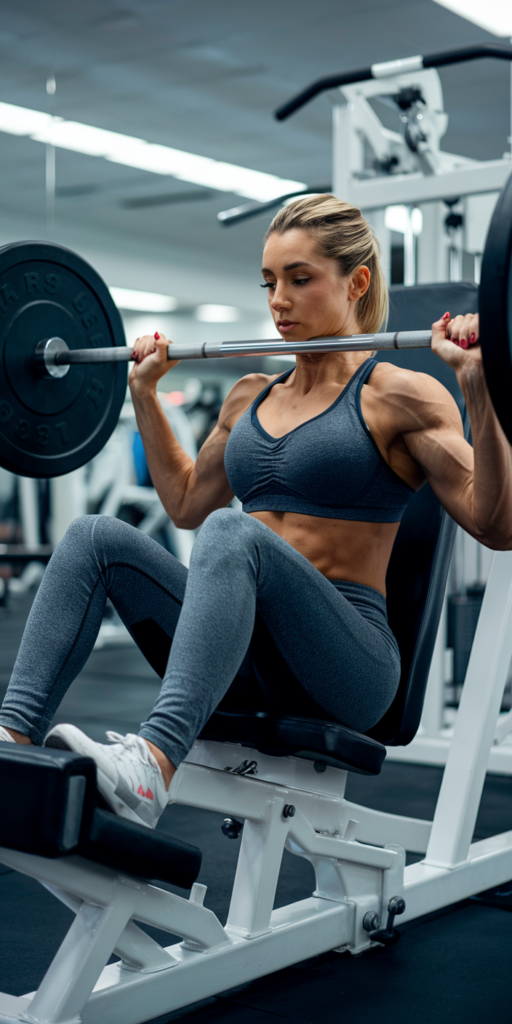
How to Perform Seated Calf Raises
- Starting Position: Sit on a calf raise machine or a bench with your knees bent at 90 degrees and feet flat on the floor.
- If using a machine, place the balls of your feet on the platform and the pads on your knees.
- If using free weights, hold a dumbbell on each knee while keeping your feet on a stable surface.
- Movement:
- Push through the balls of your feet to lift your heels as high as possible.
- Pause for 1–2 seconds at the top for a strong contraction.
- Lowering Phase: Slowly lower your heels below the level of the platform to fully stretch the soleus.
- Repetitions & Sets:
- Beginners: 3 sets of 12–15 reps
- Advanced: 4–5 sets of 15–25 reps, optionally adding heavier weight for progressive overload
Tips for Maximum Effectiveness
- Slow and controlled: Avoid bouncing; control both the upward and downward movement.
- Full stretch: Lower your heels fully to stretch the soleus, which enhances growth.
- Progressive overload: Gradually increase resistance to continuously challenge the muscle.
- Consistency: Train calves 2–3 times per week to promote growth and endurance.
Variations
- Single-leg seated calf raises: Focus on one leg at a time to correct imbalances.
- Using resistance bands: If you don’t have a machine, loop a band around your feet and apply tension while performing the movement.
- Elevated foot position: Place the balls of your feet on a small block to increase the range of motion.
Benefits
- Targets the soleus muscle, crucial for calf thickness and lower leg endurance.
- Improves ankle stability and posture.
- Enhances performance in running, jumping, and walking.
- Supports balanced calf aesthetics by complementing the gastrocnemius from standing raises.
Bottom line: Seated calf raises are essential for developing the soleus muscle, adding depth and thickness to the lower legs.
Combined with standing calf raises, they create balanced, strong, and visually defined calves while improving functional performance in daily activities and sports.
3. Donkey Calf Raises
Donkey calf raises are widely regarded as one of the most effective exercises for sculpting the calves.
Unlike standing or seated calf raises, this exercise allows for a full stretch and contraction of the gastrocnemius, which is the prominent upper portion of the calf.
While it may seem old-school, donkey calf raises have stood the test of time in bodybuilding because they develop both size and definition in a way few other exercises can.
Many people overlook the calves, focusing on quads, hamstrings, and glutes.
However, strong, well-shaped calves not only improve aesthetics but also enhance athletic performance, stability, and overall lower body strength.
Donkey calf raises are particularly valuable for individuals seeking a complete lower leg routine.
Anatomy Focus: Gastrocnemius and Soleus
The donkey calf raise primarily targets the gastrocnemius, but the soleus also contributes, especially when the knees are slightly bent.
- Gastrocnemius: This is the large, visible muscle that gives your calf its characteristic shape. It crosses both the knee and ankle joints, meaning it contributes to knee flexion and plantar flexion (pointing your toes downward). The donkey calf raise positions the hips and torso in a way that maximizes the stretch and contraction of this muscle.
- Soleus: Located beneath the gastrocnemius, the soleus supports endurance and stabilizes the ankle. While seated calf raises more directly target the soleus, donkey raises still engage it, particularly during slow, controlled movements.
Understanding this anatomy helps lifters focus on the mind-muscle connection, which is key for stimulating growth and maximizing results.
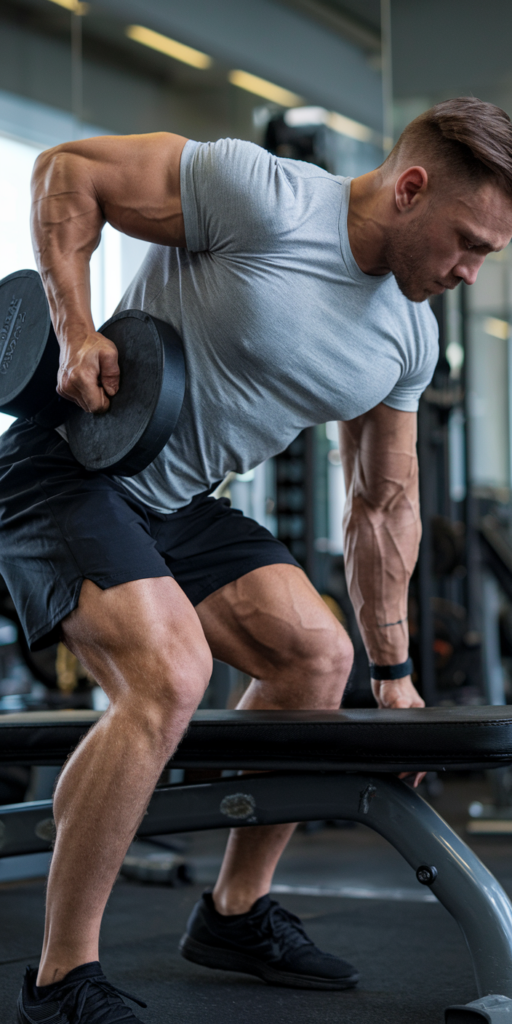
How to Perform Donkey Calf Raises
- Starting Position:
- Lean forward at the hips and place your hands on a sturdy surface such as a bench, squat rack, or bar for balance.
- Position the balls of your feet on an elevated platform or step, letting your heels hang freely.
- If using added resistance, a partner can press gently on your lower back, or you can wear a weighted dip belt or vest.
- Execution:
- Push through the balls of your feet, lifting your heels as high as possible. Focus on squeezing your calves at the top.
- Hold the contraction for 1–2 seconds to maximize muscle activation.
- Slowly lower your heels below the platform for a full stretch, feeling tension along the entire calf.
- Repetitions and Sets:
- Beginners: 3 sets of 12–15 reps
- Intermediate: 4 sets of 15–20 reps
- Advanced: 4–5 sets of 20–25 reps with added weight for progressive overload
Tips for Maximum Effectiveness
- Full Range of Motion: Achieve a deep stretch at the bottom and full contraction at the top for optimal muscle stimulation.
- Slow, Controlled Movements: Avoid bouncing, which reduces effectiveness and increases the risk of injury.
- Progressive Overload: Gradually add weight or resistance over time to continually challenge the muscle.
- Focus on Form: Keep your back straight, maintain proper alignment, and avoid locking your knees to prevent strain.
- Consistency: Calves are endurance-oriented muscles that respond well to frequent, moderate-intensity training 2–3 times per week.
Variations to Keep Your Routine Fresh
- Bodyweight Donkey Calf Raises: Ideal for beginners or as a warm-up.
- Weighted Donkey Raises: Use a dip belt or weighted vest to add resistance and increase muscle growth.
- Single-Leg Donkey Raises: Focus on one calf at a time to correct imbalances and improve symmetry.
- Incline or Decline Foot Position: Adjust the platform to emphasize different angles of the gastrocnemius.
Benefits of Donkey Calf Raises
- Maximizes Gastrocnemius Activation: Unique positioning allows for deep stretch and peak contraction, stimulating hypertrophy.
- Enhances Lower Leg Strength: Improves running, jumping, sprinting, and athletic performance.
- Improves Flexibility and Mobility: Full-range motion stretches the Achilles tendon and ankle, reducing risk of injuries.
- Supports Aesthetic Development: Complements standing and seated calf raises for well-rounded calf shape.
- Boosts Functional Performance: Strengthens muscles that stabilize ankles and knees, improving balance and daily movement efficiency.
- Engages Mind-Muscle Connection: Allows lifters to focus on isolating the calves, which is often neglected in compound lower body movements.
Common Mistakes to Avoid
- Using Too Much Weight Too Soon: This can compromise form and reduce the effectiveness of the exercise.
- Bouncing or Jerking Movements: Reduces muscle tension and increases the risk of injury.
- Neglecting Full Stretch: Partial range of motion limits growth and flexibility improvements.
- Ignoring Frequency: Calves respond well to frequent training; hitting them once a week may not yield optimal results.
Bottom line: Donkey calf raises are an essential exercise for anyone serious about developing strong, defined, and functional calves.
By providing a unique combination of deep stretch, peak contraction, and targeted gastrocnemius activation, this exercise helps lifters achieve balanced lower leg development, improve athletic performance, and enhance aesthetic appeal.
Combined with standing and seated calf exercises, donkey calf raises can transform underdeveloped calves into muscular, sculpted, and highly functional lower legs.
4. Jump Rope
Jump rope is often thought of as a cardiovascular exercise, but it’s also an excellent way to strengthen and define the calves.
This simple yet highly effective movement engages the gastrocnemius and soleus muscles while improving endurance, coordination, and lower leg aesthetics.
Incorporating jump rope into your routine is ideal for those who want lean, toned calves without relying solely on weightlifting exercises.
Why Jump Rope Is Effective for Calves
Jumping rope is a high-repetition, low-impact calf exercise that trains the muscles in a way traditional weightlifting cannot replicate:
- High Repetition Muscle Activation: With hundreds of jumps per session, your calves endure continuous contraction, which promotes muscle endurance and toning.
- Dynamic Range of Motion: The calves contract with each jump, and the slight stretch when landing enhances flexibility and muscle elasticity.
- Functional Strength: Jump rope trains the calves to stabilize the ankle and foot during rapid, repetitive movements, improving balance and agility.
- Calorie Burn and Fat Loss: Because it’s a full-body exercise, jump rope helps reduce body fat, allowing calf muscles to become more visible and defined.
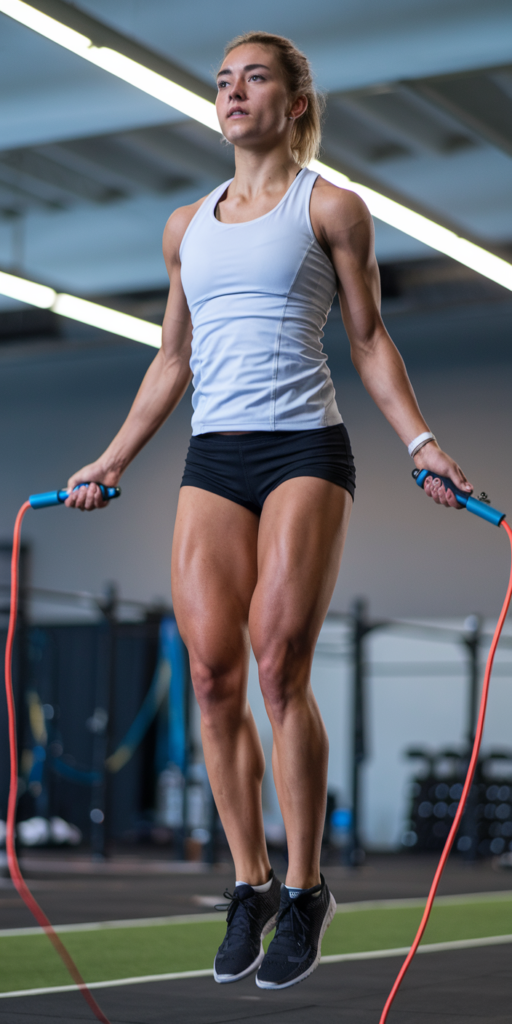
How to Perform Jump Rope for Calves
- Equipment: Use a standard jump rope or weighted jump rope for added resistance.
- Starting Position:
- Hold the rope handles lightly at your sides with elbows close to your body.
- Stand on the balls of your feet with heels slightly off the ground.
- Movement:
- Swing the rope over your head and jump just high enough to let it pass under your feet.
- Land softly on the balls of your feet to engage the calves without putting stress on the knees.
- Repetitions & Timing:
- Beginners: 5–10 minutes of continuous jumping, split into 1–2 minute intervals.
- Intermediate: 10–20 minutes with short breaks.
- Advanced: 20–30 minutes with high-intensity intervals or weighted rope for added resistance.
Tips for Maximum Calf Engagement
- Stay on the balls of your feet: Avoid landing flat-footed to maximize gastrocnemius and soleus activation.
- Keep a slight bend in the knees: This prevents impact injuries and allows better shock absorption.
- Use controlled, rhythmic jumps: Avoid high jumps; the goal is consistent, frequent calf engagement.
- Mix footwork: Single-leg jumps, alternating feet, or side-to-side jumps increase calf activation and coordination.
- Progressive overload: Increase duration, intensity, or rope weight over time for continued growth and endurance gains.
Variations to Intensify Calf Training
- Single-leg jump rope: Focus on one calf at a time for greater activation and balance improvement.
- Weighted rope jumps: Add a weighted rope to increase resistance, strengthening calves and forearms simultaneously.
- Boxer step: Shift weight between feet while jumping for a low-impact, endurance-focused variation.
- High knees with rope: Increase intensity and engage calves, quads, and hip flexors simultaneously.
Benefits of Jump Rope for Calves
- Improves Muscle Endurance: Continuous jumping builds stamina in both the gastrocnemius and soleus.
- Enhances Definition: High-repetition activation helps create lean, toned calves.
- Boosts Cardiovascular Health: Jump rope strengthens the heart while simultaneously working the lower legs.
- Improves Balance and Coordination: Fine-tunes ankle stability, which benefits sports and daily movement.
- Accessible Anywhere: Minimal equipment needed—perfect for home workouts, travel, or gym sessions.
- Functional Strength: Supports running, sprinting, and jumping by training calves to respond dynamically.
Common Mistakes to Avoid
- Landing flat-footed: Reduces calf engagement and increases impact on knees.
- Jumping too high: Wastes energy and may lead to fatigue without effectively targeting calves.
- Poor rope technique: Twisting wrists excessively or using arms instead of wrists reduces efficiency.
- Skipping progression: Start slowly and increase time and intensity gradually to avoid injury.
Bottom line: Jump rope is a versatile, effective, and functional exercise for calf development.
It targets both the gastrocnemius and soleus, improves endurance, enhances definition, and supports overall athletic performance.
When combined with standing, seated, and donkey calf raises, jump rope can transform calves into strong, toned, and aesthetically pleasing lower legs while improving cardiovascular fitness and coordination.
5. Box Jumps
Box jumps are a powerful plyometric exercise that target the calves, glutes, quads, and hamstrings while also improving explosive strength, agility, and coordination.
While many people focus on how box jumps build leg power, the calves play a critical role in generating the force needed to propel the body upward.
Including box jumps in your routine can help develop strong, defined calves as well as improve overall athletic performance.
Why Box Jumps Are Effective for Calves
Box jumps primarily engage the gastrocnemius during the explosive push-off phase, while the soleus stabilizes the ankle upon landing. Key benefits for calf development include:
Endurance & Stability: Repeated jumps train the calves to sustain performance over multiple repetitions, enhancing stamina and ankle stability.
Explosive Contraction: The jump requires a rapid, forceful push from the balls of your feet, which fully engages the gastrocnemius.
Stretch-Shortening Cycle: Plyometric movements like box jumps take advantage of the natural elastic properties of the calf muscles, increasing power and promoting muscle growth.
Functional Strength: Calves develop the ability to generate force quickly, improving sprinting, jumping, and agility.
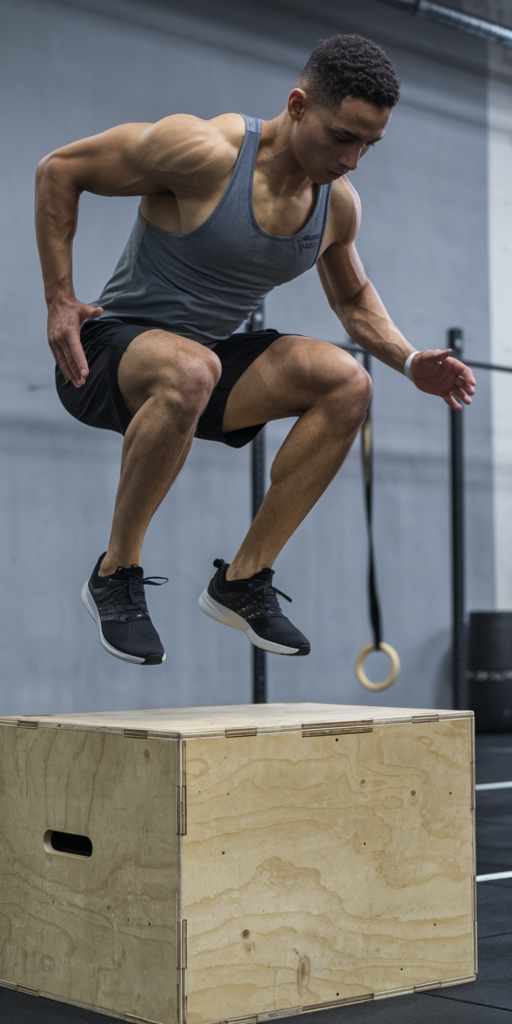
How to Perform Box Jumps
- Equipment: Use a sturdy plyometric box or platform appropriate for your skill level.
- Starting Position:
- Stand facing the box with feet hip-width apart.
- Engage your core and slightly bend your knees.
- Execution:
- Swing your arms backward and then forward as you push off the balls of your feet, jumping explosively onto the box.
- Land softly on the balls of your feet, bending your knees slightly to absorb impact.
- Step down carefully, one foot at a time, rather than jumping down, to reduce strain on the calves and joints.
- Repetitions & Sets:
- Beginners: 3 sets of 8–10 jumps
- Intermediate: 4 sets of 10–12 jumps
- Advanced: 4–5 sets of 12–15 jumps, optionally increasing box height for added difficulty
Tips for Maximum Calf Engagement
- Use the Balls of Your Feet: Focus on pushing off from the balls of your feet to fully activate the gastrocnemius.
- Soft Landings: Absorb the impact with your calves and quads to protect your joints.
- Arm Swing: Use your arms to generate momentum, which allows for higher jumps without sacrificing calf engagement.
- Progress Gradually: Start with a lower box and gradually increase height to avoid injury.
- Frequency: Include box jumps 2–3 times per week, allowing recovery between plyometric sessions.
Variations to Challenge Calves Further
- Weighted Box Jumps: Hold light dumbbells or a kettlebell to increase resistance and muscle activation.
- Single-Leg Box Jumps: Focus on one leg at a time to correct imbalances and enhance unilateral calf strength.
- Tuck Jumps to Box: Add a knee tuck while jumping for increased explosiveness and additional calf engagement.
- Lateral Box Jumps: Jump side-to-side to train the calves and ankle stabilizers in multiple planes.
Benefits of Box Jumps for Calves
- Build Explosive Calf Power: Rapid push-off enhances gastrocnemius strength.
- Enhances Definition and Shape: High-repetition, dynamic contractions promote muscle toning.
- Improves Athletic Performance: Supports sprinting, jumping, and agility movements in sports.
- Increases Endurance: Repeated jumps train the calves to maintain performance over time.
- Functional Movement Training: Mirrors real-life movements like jumping, climbing, and sprinting.
- Boosts Coordination and Balance: Engages stabilizing muscles in the calves and ankles for improved proprioception.
Common Mistakes to Avoid
- Jumping Too High Too Soon: This can compromise form and increase the risk of injury.
- Landing Flat-Footed: Reduces calf activation and stresses the knees.
- Ignoring Soft Landings: Hard landings can strain the calves, knees, and ankles.
- Overtraining: Plyometric exercises require recovery; perform box jumps 2–3 times per week for optimal results.
Bottom line: Box jumps are a dynamic, plyometric exercise that strengthens, defines, and sculpts the calves while improving overall leg power, agility, and functional fitness.
When combined with standing, seated, donkey calf raises, and jump rope, box jumps ensure well-rounded lower leg development, enhancing both aesthetics and athletic performance.
I can continue with 6. Hill Sprints for Calves next, making it long and detailed, explaining how incline running specifically targets calf growth and endurance.
Do you want me to continue with that?
6. Tibialis Raises
While much of calf training focuses on the gastrocnemius and soleus, the tibialis anterior—the muscle on the front of your lower leg—is just as important for balanced lower leg development, ankle stability, and injury prevention.
Tibialis raises (or toe raises) specifically target this muscle, helping prevent shin splints, improve gait, and enhance overall calf aesthetics.
Incorporating tibialis raises into your routine ensures that your lower legs are strong, functional, and well-balanced.
Why Tibialis Raises Are Important
Many people neglect the tibialis anterior, focusing solely on calf muscles at the back of the leg. This imbalance can lead to:
- Weak ankle dorsiflexion, affecting walking, running, and jumping.
- Higher risk of shin splints and lower leg injuries.
- Uneven lower leg development, which can impact aesthetics and posture.
Tibialis raises strengthen the muscle responsible for lifting your foot upward (dorsiflexion), creating better balance between the front and back of the lower leg.
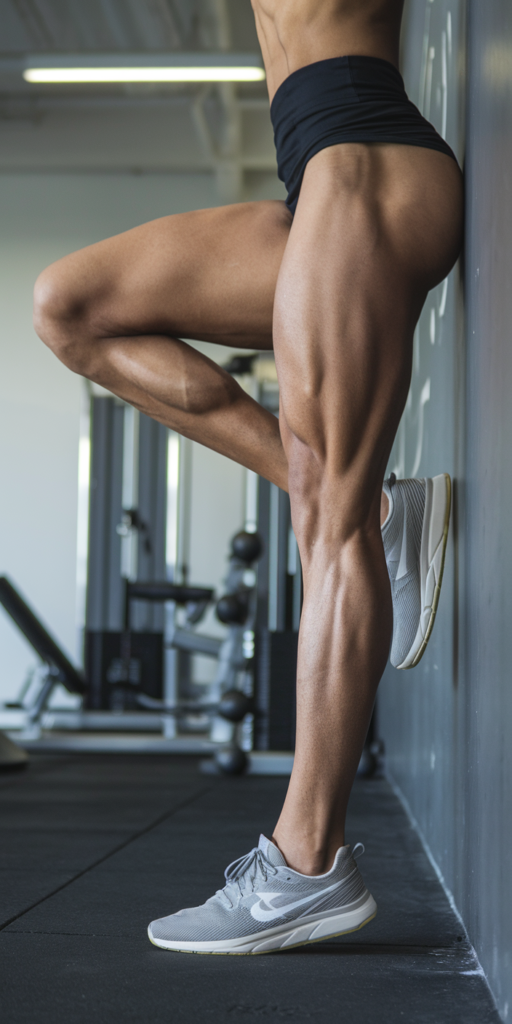
How to Perform Tibialis Raises
- Starting Position:
- Stand with your back against a wall or hold onto a stable surface for balance.
- Place your heels on the ground with toes pointing forward.
- Optional: Use a resistance band around your foot for added difficulty.
- Movement:
- Lift your toes toward your shins as high as possible, contracting the tibialis anterior.
- Hold for 1–2 seconds at the top for maximum engagement.
- Slowly lower your toes back to the starting position.
- Repetitions & Sets:
- Beginners: 2–3 sets of 12–15 reps
- Intermediate: 3–4 sets of 15–20 reps
- Advanced: 4–5 sets of 20–25 reps or use ankle weights for additional resistance
Tips for Maximum Effectiveness
- Controlled Movement: Avoid fast, jerky motions; slow and steady raises ensure proper muscle activation.
- Mind-Muscle Connection: Focus on contracting the tibialis anterior during each rep.
- Use Resistance Gradually: Add bands or ankle weights progressively to continue challenging the muscle.
- Consistency: Include tibialis raises 2–3 times per week, especially if you perform heavy calf workouts or run frequently.
Variations to Target the Tibialis Anterior
- Seated Tibialis Raises: Sit on a bench with feet flat and lift the toes while keeping heels grounded, optionally with resistance bands.
- Weighted Tibialis Raises: Attach ankle weights or hold a light dumbbell on top of the foot to increase intensity.
- Resistance Band Dorsiflexion: Anchor a resistance band and pull the toes toward your shins against tension for a controlled contraction.
- Single-Leg Raises: Focus on one leg at a time to correct imbalances and strengthen weak areas.
Benefits of Tibialis Raises
- Balanced Lower Leg Development: Strengthens the front of the leg to complement calf muscles, creating a symmetrical appearance.
- Prevents Shin Splints: Strong tibialis anterior reduces strain and discomfort associated with running or high-impact exercises.
- Improves Athletic Performance: Enhances sprinting, jumping, and foot control by improving dorsiflexion strength.
- Enhances Ankle Stability: Supports proper movement patterns and reduces the risk of ankle injuries.
- Functional Fitness: Assists in walking, climbing stairs, and other everyday movements that rely on ankle and foot mobility.
Bottom line: Tibialis raises are an often-overlooked exercise that strengthens the front of the lower leg, promotes balanced calf development, and enhances overall lower leg functionality.
When combined with exercises targeting the gastrocnemius and soleus—like standing, seated, and donkey calf raises—tibialis raises help create strong, defined, and injury-resistant lower legs.
Calf Workouts for Mass, Endurance, and Definition
The calves are often the most undertrained muscles in the lower body, yet they are critical for both aesthetic appeal and functional performance.
Unlike many other muscles, calves are highly endurance-oriented due to their role in everyday movements such as walking, running, and jumping.
At the same time, they respond well to strength and hypertrophy training, which makes them unique.
Developing calves for mass, endurance, and definition requires a thoughtful combination of exercises, proper technique, and structured programming.
Many lifters struggle to grow their calves, often citing genetics as the reason.
While genetics do play a role in muscle shape and insertion points, the main factors limiting growth are often training frequency, variety, and intensity.
Calves contain a mix of fast-twitch and slow-twitch muscle fibers, meaning they thrive on both high-rep endurance work and heavy, low-rep strength training.
Understanding Calf Anatomy
The calf is composed of two main muscles and one important accessory muscle:
- Gastrocnemius – The prominent, visible muscle of the upper calf.
- Primarily fast-twitch fibers, making it ideal for explosive and heavy movements like jumps and standing calf raises.
- Crosses both the knee and ankle joint, meaning its function is influenced by knee position.
- Soleus – Lies beneath the gastrocnemius and is critical for posture and endurance.
- Primarily slow-twitch fibers, making it suited for high-rep movements like seated calf raises or jump rope.
- Tibialis Anterior – Located on the front of the lower leg, it controls dorsiflexion (lifting the toes toward the shins).
- Strengthening this muscle balances the calves, prevents shin splints, and enhances lower leg aesthetics.
Because of this combination of fiber types, an effective calf routine must stimulate both fast-twitch and slow-twitch fibers, using a variety of exercises, rep ranges, and tempos.
Training for Calf Mass
To achieve bigger, thicker calves, the focus should be on progressive overload and exercises that emphasize full range of motion and peak contraction:
- Standing Calf Raises: Target the gastrocnemius for size. Heavy weight, slow controlled reps, and squeezing at the top maximize hypertrophy.
- Donkey Calf Raises: Provide a unique stretch and contraction, allowing for more muscle activation and growth.
- Weighted Box Jumps: Explosive movements stimulate fast-twitch fibers, contributing to calf thickness.
Training Tips for Mass:
- Use heavier loads and moderate rep ranges (8–12 reps) for maximal growth.
- Focus on slow eccentric movements: lowering the heels slowly increases time under tension.
- Incorporate drop sets, supersets, or pyramids to further challenge the calves.
- Train calves at the beginning of the workout if your goal is hypertrophy, when you have maximum energy.
Training for Calf Endurance
Calves are naturally endurance-oriented, so training them for long, lean, resilient lower legs is equally important:
- Seated Calf Raises: Focus on the soleus. High reps (15–25) improve endurance while promoting vascularity and definition.
- Jump Rope: Continuous high-repetition movements develop both endurance and cardiovascular fitness.
- Hill Sprints: Running uphill forces calves to work explosively while building stamina.
Training Tips for Endurance:
- Use high-repetition sets with short rest intervals (30–60 seconds) to maintain tension.
- Focus on controlled contractions rather than speed or momentum.
- Include 2–3 sessions per week, depending on recovery, to build lasting endurance.
Training for Calf Definition
Definition comes from a combination of muscle development, fat reduction, and muscle tone. To achieve sculpted calves:
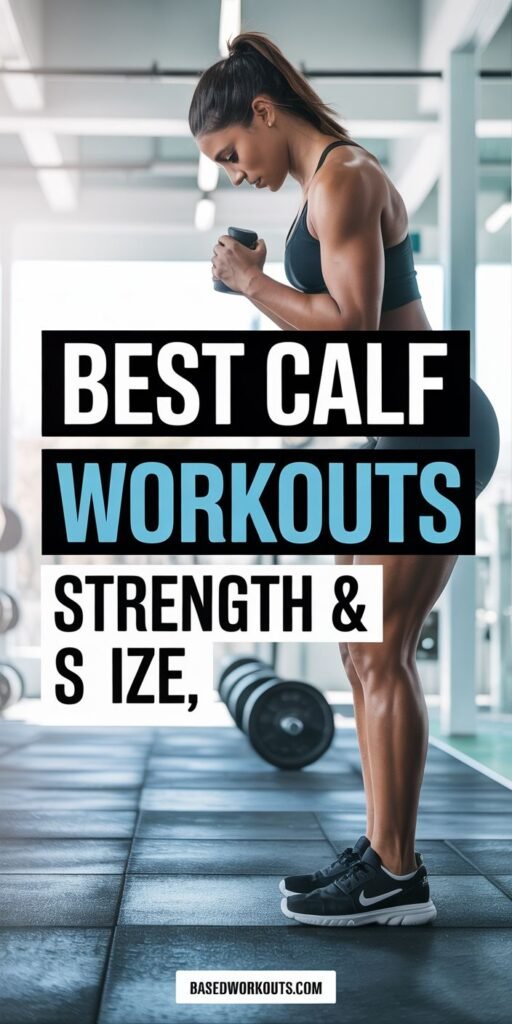
- Tibialis Raises: Strengthen the front of the lower leg for balanced aesthetics.
- Farmer’s Walk on Toes: Builds calf endurance, stability, and definition.
- Plyometric Movements: Box jumps, lateral hops, and high knees improve definition while stimulating both fast- and slow-twitch fibers.
Training Tips for Definition:
- Emphasize full range of motion to maximize the visible contour of the calf.
- Include high-repetition, low-weight exercises to enhance vascularity and tone.
- Combine with a healthy diet to reduce fat covering the calves, making muscle definition more visible.
Sample Comprehensive Calf Workout for Mass, Endurance, and Definition
- Standing Calf Raises: 4–5 sets of 10–12 reps (heavy)
- Seated Calf Raises: 3 sets of 20–25 reps
- Donkey Calf Raises: 4 sets of 12–15 reps
- Jump Rope Intervals: 5–10 minutes, alternating 30–60 seconds high intensity and short rests
- Tibialis Raises: 3 sets of 15–20 reps
- Box Jumps or Farmer’s Walk on Toes: 3 sets of 12–15 reps
This routine ensures your calves are trained for strength, endurance, and definition in a single session, hitting all relevant muscles and fiber types.
Additional Tips for Maximum Calf Development
- Train Calves Frequently: 2–3 sessions per week are ideal for growth, endurance, and definition.
- Mind-Muscle Connection: Focus on feeling the calf muscles work with each repetition.
- Vary Rep Ranges and Tempo: Incorporate heavy sets, high-rep sets, and slow negatives to target all muscle fibers.
- Progressive Overload: Gradually increase resistance, volume, or intensity for continual improvement.
- Proper Nutrition and Recovery: Adequate protein, calories, and rest are essential for muscle repair and growth.
- Consistency Over Time: Calves may take longer to develop due to constant daily use, so persistence is key.
Bottom line: To build calves that are strong, well-shaped, and defined, a comprehensive approach is necessary.
Combining mass-building exercises, endurance training, and definition-focused movements ensures balanced growth, injury prevention, and functional performance.
With dedication, proper technique, and consistency, your calves can become muscular, resilient, and visually impressive, complementing your overall leg development.
Common Calf Training Mistakes & How to Fix Them
The calves are deceptively difficult to train effectively. Many people struggle to see size, definition, or strength gains despite years of effort.
This is often because of common mistakes in form, volume, and exercise selection.
Understanding these errors and how to correct them is essential for building strong, well-shaped, and functional calves.
1. Using Too Much Weight, Too Soon
The Mistake: Loading the calves with excessive weight can lead to poor form, limited range of motion, and even injury.
Many lifters assume heavier equals better results, but calves respond better to controlled, deliberate movements.
How to Fix It:
- Start with a manageable weight that allows you to perform full range of motion reps.
- Focus on slow, controlled eccentric movements (lowering your heels slowly).
- Gradually increase weight over time, ensuring form is never compromised.
2. Neglecting Full Range of Motion
The Mistake: Many people perform calf raises with partial motion, barely lifting their heels or failing to lower fully. This limits muscle activation and growth.
How to Fix It:
- Stretch at the bottom: Allow your heels to drop below the platform or floor level.
- Squeeze at the top: Pause and contract the calves fully when standing on tiptoes.
- This ensures both the gastrocnemius and soleus are engaged throughout the movement.
3. Focusing Only on Standing Calf Raises
The Mistake: Relying solely on standing calf raises neglects the soleus and tibialis anterior. This can cause imbalanced calves and reduced functional strength.
How to Fix It:
- Include seated calf raises to target the soleus.
- Add tibialis raises for the front of the lower leg.
- Mix in plyometric exercises like jump rope or box jumps to target fast-twitch fibers.
4. Ignoring Frequency and Volume
The Mistake: Calves are used to daily activity, so training them once a week is usually insufficient. Low frequency and volume prevent growth and definition.
How to Fix It:
- Train calves 2–3 times per week, using different rep ranges and exercises.
- Include both low-rep heavy sets and high-rep endurance sets to stimulate all muscle fibers.
- Consistency over time is more important than occasional intense sessions.
5. Using Momentum Instead of Muscle Activation
The Mistake: Bouncing or using momentum to lift the weight shifts tension away from the calves and reduces effectiveness.
How to Fix It:
- Perform each repetition slowly and deliberately.
- Focus on feeling the contraction and stretch in the muscle.
- Avoid “cheating” by using your arms, hips, or upper body to move the weight.
6. Skipping Warm-Up and Mobility Work
The Mistake: Calves are prone to tightness, which can lead to strain or injury if trained cold. Many skip proper warm-up or stretching.
How to Fix It:
- Perform dynamic stretches like ankle circles, calf raises without weight, or jump rope for 3–5 minutes before heavy training.
- Include post-workout static stretches to improve flexibility and recovery.
7. Neglecting Recovery
The Mistake: Overtraining calves or not allowing recovery can limit growth and cause soreness or injury.
How to Fix It:
- Allow 48 hours between intense calf sessions.
- Use foam rolling, massage, and proper nutrition to aid recovery.
- Remember that muscle growth occurs during rest, not just during training.
8. Ignoring Foot Placement Variations
The Mistake: Performing calf exercises with the same stance every time can limit muscle development and lead to imbalances.
How to Fix It:
- Vary foot positions: toes pointing forward, outward, or inward.
- This targets different fibers of the gastrocnemius and soleus.
- Include single-leg variations to correct asymmetries and improve balance.
9. Not Tracking Progress
The Mistake: Training calves without tracking reps, sets, or resistance makes it hard to know if progress is being made.
How to Fix It:
- Keep a training log with exercises, weights, reps, and rest periods.
- Gradually increase either weight, reps, or time under tension for progressive overload.
- Monitor visual changes and strength improvements over time to stay motivated.
Bottom Line
Building strong, defined calves requires more than just standing on your toes with a heavy weight. Avoiding these common mistakes—including poor form, insufficient frequency, lack of variety, and neglecting recovery—will allow you to:
- Develop well-rounded calves that look and perform great.
- Increase muscle endurance and explosive strength.
- Prevent injuries and maintain lower leg health.
- Achieve a balanced, aesthetically pleasing lower leg profile that complements your overall physique.
By combining proper technique, variety, progressive overload, and recovery, your calf training can finally deliver visible, functional, and impressive results.
Tips for Faster Calf Muscle Growth
Calves are one of the most stubborn muscle groups to grow, largely because they are used to constant daily activity and have a high proportion of slow-twitch fibers.
Many lifters hit the gym regularly yet see minimal progress in calf size.
To accelerate calf growth, you need a strategic approach that combines proper exercise selection, intensity, volume, frequency, and recovery.
Below are proven tips to help you maximize calf development effectively.
1. Prioritize Full Range of Motion
One of the most important factors for calf growth is training through a full range of motion. Partial reps may feel easier, but they fail to fully stimulate the gastrocnemius and soleus.
How to Apply:
- Lower your heels below the platform during calf raises to stretch the muscle.
- Stand tall and squeeze at the top, rising onto your toes fully.
- Focus on slow eccentric movements, taking 2–3 seconds to lower the weight.
Full range of motion ensures maximum muscle fiber recruitment, which leads to greater hypertrophy over time.
2. Incorporate Both Heavy and High-Rep Training
Calves contain both slow-twitch and fast-twitch fibers, so a combination of heavy low-rep sets and lighter high-rep sets is necessary for balanced growth.
Practical Approach:
- Heavy sets (6–12 reps) for standing calf raises, donkey calf raises, or weighted box jumps.
- High-rep sets (20–50 reps) for seated calf raises, jump rope, or bodyweight calf raises.
- Alternating rep ranges throughout the week ensures you hit all fiber types.
This strategy allows you to build size, endurance, and definition simultaneously.
3. Train Calves Frequently
Because calves are used to walking and standing daily, they can tolerate higher training frequency than many other muscles. Training them once a week often limits growth potential.
How to Apply:
- Train calves 2–4 times per week, incorporating a mix of mass, endurance, and definition exercises.
- Use different angles and exercises to prevent adaptation.
- Include calves in both lower body and full-leg workouts to maximize stimulation.
4. Focus on Time Under Tension
Calves respond exceptionally well to slow, controlled movements. Time under tension (TUT) emphasizes the contraction and stretch of the muscles, which is critical for hypertrophy.
How to Apply:
- Lower your heels over 2–3 seconds (eccentric phase).
- Pause for 1–2 seconds at the top of the movement.
- Avoid bouncing or using momentum, which reduces muscle engagement.
5. Use Progressive Overload
To grow calves faster, progressive overload is key. Increasing weight, reps, or intensity gradually forces the muscles to adapt.
How to Apply:
- Track your weights, reps, and sets for each calf exercise.
- Aim to increase one variable at a time: add 5–10 pounds, 2–3 reps, or an extra set every 1–2 weeks.
- Use advanced techniques like drop sets, supersets, or slow negatives once you plateau.
6. Incorporate Plyometric and Functional Movements
Explosive movements like box jumps, jump rope, and hill sprints target the calves’ fast-twitch fibers and improve muscle definition, strength, and power.
How to Apply:
- Add 2–3 plyometric sessions per week to your calf training routine.
- Focus on landing softly and pushing off with the balls of your feet.
- Include single-leg variations to correct imbalances and increase muscle activation.
7. Strengthen the Tibialis Anterior
Balanced lower leg development requires working the tibialis anterior, which supports ankle stability, improves gait, and enhances overall calf appearance.
How to Apply:
- Perform tibialis raises 2–3 times per week.
- Include resistance bands or ankle weights to progressively challenge the muscle.
- Single-leg variations help correct asymmetries and improve functional performance.
8. Prioritize Recovery and Nutrition
Calves, like all muscles, grow outside the gym. Adequate recovery and proper nutrition are crucial for faster results.
How to Apply:
- Allow 48–72 hours of recovery between intense calf sessions.
- Stretch and foam roll calves post-workout to improve flexibility and blood flow.
- Eat enough protein and calories to support muscle repair and growth.
- Stay hydrated to optimize performance and reduce cramping.
9. Track Progress and Adjust
Without tracking, it’s difficult to know if your calves are actually improving. Regular monitoring helps you identify what works and adjust your plan.
How to Apply:
- Keep a training journal with exercises, reps, sets, and weights.
- Take weekly photos or measure calf circumference for visual tracking.
- Adjust exercises, volume, or intensity every 4–6 weeks for continued growth.
Bottom Line
Faster calf growth requires a strategic, consistent, and varied approach. By focusing on:
- Full range of motion
- Heavy and high-rep training
- Frequent stimulation
- Time under tension and progressive overload
- Plyometrics, tibialis training, and recovery
…you can overcome genetic limitations and develop strong, muscular, and well-defined calves. The key is consistency, proper technique, and patient progression,
which ultimately leads to lower legs that are both functional and aesthetically impressive.
Frequently Asked Questions (FAQ)
1. Why are my calves so hard to grow?
Calves are naturally stubborn due to their high slow-twitch fiber composition and constant daily use. They are designed for endurance, meaning they are already trained by walking and standing. To stimulate growth, you need progressive overload, full range of motion, and varied rep ranges targeting both fast- and slow-twitch fibers.
2. How often should I train calves?
For optimal growth, calves should be trained 2–4 times per week. This frequency allows sufficient stimulation for hypertrophy while still giving the muscles time to recover. Incorporating both heavy low-rep exercises and high-rep endurance work ensures balanced development.
3. Should I use heavy weights or high reps?
Both approaches are important. Heavy weights (6–12 reps) target the gastrocnemius for size, while high reps (20–50) target the soleus and improve endurance and definition. Alternating between these rep ranges ensures you train all muscle fibers effectively.
4. Are standing or seated calf raises better?
Both are essential. Standing calf raises target the gastrocnemius, which crosses the knee and ankle joints. Seated calf raises isolate the soleus, which is more active when the knee is bent. Using both exercises ensures complete calf development.
5. How long will it take to see results?
Visible calf growth depends on genetics, training intensity, and nutrition. Most lifters see noticeable results in 6–12 weeks with consistent, progressive training. Measuring circumference, taking photos, and tracking performance can help monitor progress.
6. Can I train calves every day?
While calves are endurance-oriented, daily high-intensity training is not recommended. Overtraining can lead to fatigue, poor performance, or injury. Training 2–3 times per week with proper recovery is usually sufficient.
7. Do plyometrics help build calves?
Yes. Plyometric exercises like box jumps, jump rope, and single-leg hops engage fast-twitch fibers, improve explosive strength, and enhance definition. They complement weighted exercises for balanced calf development.
8. Should I include tibialis anterior exercises?
Absolutely. Strengthening the tibialis anterior prevents muscle imbalances, shin splints, and ankle injuries, while also improving lower leg aesthetics. Tibialis raises or resistance band dorsiflexion are excellent additions.
9. Is stretching important for calves?
Yes. Dynamic stretches before workouts increase blood flow and range of motion, while static stretches after training improve flexibility and reduce tightness. Proper stretching also enhances recovery and muscle activation during workouts.
10. Can I build calves without a gym?
Yes. Bodyweight exercises such as standing calf raises, single-leg calf raises, jump rope, and box jumps can be highly effective. Adding resistance bands or household weights can further increase intensity for hypertrophy.
11. How do I prevent calf injuries?
- Warm up with dynamic movements.
- Train with controlled form and proper weight.
- Include balanced exercises for gastrocnemius, soleus, and tibialis anterior.
- Stretch and foam roll post-workout.
- Allow adequate recovery between sessions.
12. How do I make calves more defined?
Definition comes from muscle growth combined with low body fat. Include:
- High-rep sets and plyometric exercises.
- Full range of motion for every rep.
- A balanced diet to reduce fat covering the calves.
- Varied foot positions and angles to stimulate all fibers.
Bottom Line
Calf growth requires a strategic combination of exercises, frequency, intensity, and recovery.
Avoiding common mistakes, training all muscle fibers, and being consistent will lead to stronger, fuller, and well-defined calves over time.
Conclusion
Developing well-shaped calves requires more than just standing on your toes with heavy weights.
The calves are unique muscles, combining endurance-oriented slow-twitch fibers with explosive fast-twitch fibers, which means they respond best to a balanced approach that includes strength, endurance, and definition training.
To truly transform your calves, focus on:
- Full range of motion: Stretch at the bottom, squeeze at the top to maximize muscle activation.
- Varied training methods: Combine standing and seated calf raises, plyometric exercises, tibialis anterior work, and bodyweight movements.
- Progressive overload: Gradually increase weight, reps, or time under tension to stimulate continual growth.
- Proper frequency and recovery: Train 2–4 times per week, allowing muscles adequate rest for repair and hypertrophy.
- Nutrition and consistency: Muscles grow outside the gym, so proper protein intake, calorie balance, and hydration are essential.
Avoid common mistakes like using momentum, partial reps, and neglecting the soleus or tibialis anterior. Instead, use a strategic plan that targets all aspects of calf development—mass, endurance, and definition.
By following these principles consistently, your calves will become strong, sculpted, and functional, enhancing not just your appearance but also your lower body strength, stability, and athletic performance.
The key takeaway is simple: consistency, proper technique, and smart programming are far more important than genetics alone.
With dedication and the right approach, even the most stubborn calves can grow into a visibly strong, defined, and balanced part of your legs.
